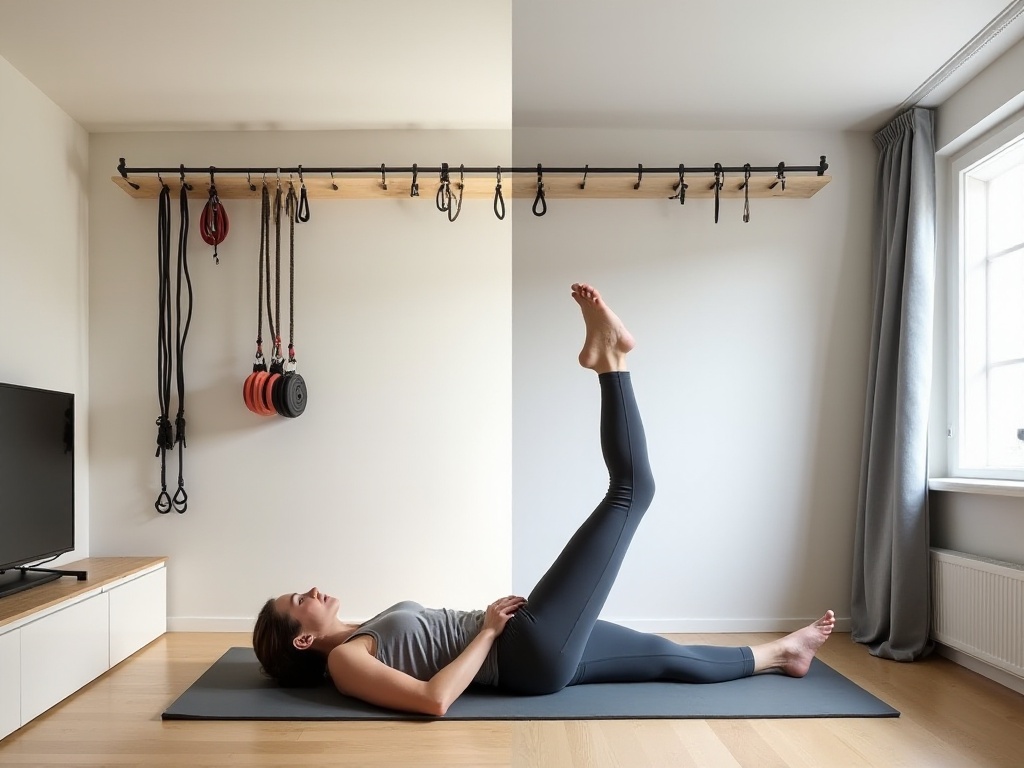Space Magic
Dedicated Workout Area
As a young person renting in a big city, I deeply understand the pressure of limited space. However, this hasn't stopped my determination to pursue a healthy lifestyle. After much thought and experimentation, I finally carved out a workout space in my little haven. Honestly, this process has given me such a sense of achievement!
My apartment is a typical 30-square-meter unit, but I managed to clear out 3 square meters in the living room corner and transform it into my dedicated workout area. This space was originally cluttered with various items but has been completely transformed after reorganization. I chose a yoga mat of suitable thickness - soft but not too soft, which helps reduce knee pressure during high knee lifts or jumping exercises.
I put a lot of effort into lighting. I positioned the workout area near the window, allowing me to enjoy abundant natural light and admire the outdoor scenery while exercising. It's especially nice in the morning when the first rays of sunlight stream in - it completely changes my energy level. I also found a 1.5-meter-tall full-length mirror online for less than 200 yuan, which works wonderfully. The mirror not only makes the space appear larger but, more importantly, helps me constantly adjust my form to avoid injury from improper posture.
Eliminating Distractions
Creating an ideal workout environment took some clever thinking. First, I put my phone on airplane mode to avoid interruptions from various notifications. It was a bit uncomfortable at first, worried about missing important messages. But after getting used to it, I found that this one hour of focused training actually improved my efficiency significantly.
I also bought a pair of reasonably priced Bluetooth noise-canceling headphones for about 300 yuan. While not top-tier, they effectively block most external noise. Especially during high-intensity training, wearing headphones and listening to energetic music helps me enter a particularly focused state.
To prevent family members from accidentally interrupting, I even designed a simple "Training in Progress" door sign. Though it seemed a bit excessive at first, it proved really effective. Now when family members see the sign, they know I'm focused on training and will deliberately move quietly without disturbing me.
Equipment Selection

Creative Use of Household Items
As a young professional who just started working, I'm well aware that professional fitness equipment isn't cheap. However, after some exploration, I discovered that many everyday items can serve great purposes. My proudest discovery is the clever use of water bottles. I specifically kept several 2-liter beverage bottles, which when filled with water are perfect weights for beginners. Plus, the weight can be adjusted according to needs - pour out some water to make it lighter, fill it up to make it heavier - very practical.
Speaking of creative uses, I think my most interesting innovation is my "book dumbbells." As a book lover, I've accumulated quite a few heavy books. I carefully selected several books of similar weight and tied them together with nylon rope, creating an eco-friendly and economical piece of training equipment. My most frequently used combination is three hardcover Chinese dictionaries, totaling about 2.25 kilograms, perfect for upper body strength training.
Sometimes I also convert my backpack into a weighted vest by filling it with books or water bottles for weight training. While it might look a bit makeshift, it works really well, and most importantly, doesn't cost much money.

Basic Equipment
While I advocate making the most of what you have, some basic equipment is worth investing in. After repeated comparison and use, I've compiled a list of highly cost-effective basic equipment.
First is the yoga mat - this is something worth spending more on. My first attempt at saving money with a 6mm cheap mat resulted in deformation after short use and knee pain during kneeling positions. Later, I spent 200 yuan on a 15mm professional yoga mat, which not only provides better cushioning but also excellent non-slip performance. This mat has maintained its quality for almost two years now.
Dumbbell selection is also crucial. I suggest beginners start light and gradually increase. I initially bought a pair of 2kg dumbbells for about 60 yuan. Only when that became too easy did I upgrade to 4kg ones. I keep both pairs now - the lighter ones for high-rep exercises and the heavier ones for strength training.
Resistance bands are what I consider the most cost-effective equipment - 50 yuan can get you a good one. They're not just for stretching but can assist with many exercises. For example, they can help make push-ups easier or add resistance to back exercises.
Regarding workout clothes, I recommend pure cotton materials. While various functional fabrics are popular now, often costing hundreds per piece, I think cotton offers the best value for home workouts. I bought several pure cotton workout T-shirts online for less than 80 yuan each, which are very comfortable. Cotton's breathability is excellent - while it absorbs sweat, it doesn't retain odors like some synthetic materials.
For pants, I chose loose-fitting athletic shorts for about 60-70 yuan each. Choose materials with some elasticity to avoid feeling restricted during movements. I especially recommend buying several pairs to rotate between washes.
Scientific Training
Time Management
As a nine-to-five office worker, I deeply understand the importance of time management. After multiple attempts and adjustments, I finally found the most suitable workout time for me. I chose to start training at 6:30 AM, which, although requiring early rising, is the time least likely to be interrupted during the day.
Maintaining early rising was initially quite challenging, especially in winter. But I noticed an interesting phenomenon: once I manage to get up and start exercising, I feel energetic for the entire day. Plus, taking a hot shower after morning exercise and eating a healthy breakfast really changes my whole state of being.
I tracked my training data for three months on my phone and found that when choosing morning workouts, my completion rate reached 85%. In comparison, when I planned evening workouts, the completion rate was only about 50% due to various reasons like overtime work, social obligations, or fatigue. This data further convinced me that morning is indeed the best time for exercise.
To ensure I wake up on time, I developed a habit of going to bed before 10 PM. While this means sacrificing some entertainment time, I think it's worth it. Good sleep patterns not only ensure training quality but also improve work efficiency.
Progressive Training
When it comes to creating a training plan, I really need to emphasize the importance of gradual progression. I remember when I first started working out, seeing those expert training videos online made me want to achieve that level immediately. The result was predictable - I strained my muscles after just three days and had to rest for two weeks to recover.
Since then, I've developed a more scientific training plan. In the first week, I only exercised for 20 minutes each session, focusing mainly on basic warm-up movements and simple strength training like modified push-ups (against the wall) and half squats. While the intensity was low, the focus was on building the exercise habit.
By the second week, I extended the training time to 25 minutes and added some new movements. For instance, I started trying standard push-ups, though I could only do 3-4 at first, it was still a good start.
In the third week, training time increased to 30 minutes, and movement form notably improved. I paid special attention to my body's responses, adjusting the next day's training content if any particular area felt especially sore.
By the fourth week, I could complete 35-minute workouts, with significant improvements in both movement quality and quantity. Only then did I consider increasing training frequency from three to four times per week.
This progressive training method might seem slow, but it's truly the safest and most effective approach. One of my colleagues now has chronic knee problems during rainy weather due to starting too aggressively.
Training Intensity
High-Intensity Training
Speaking of High-Intensity Interval Training (HIIT), I think it's really a game-changer for home workouts. This training method requires minimal equipment, takes up little space, and is incredibly effective. I now regularly use a modified training routine I developed.
Specifically, I start with 3 minutes of warm-up, including light jogging in place and simple joint mobility exercises. Then I move into the interval training: 30 seconds of jumping jacks at full intensity, followed by 30 seconds of walking in place for recovery, repeated for 8-10 sets. If I really can't keep up, I'll extend the rest period slightly, but try to maintain the workout's flow.
When I first tried this training method, it was incredibly challenging. I remember only managing 4 sets before feeling like I would collapse. But after a month of persistence, I could complete 10 sets, and my recovery speed improved significantly.
What surprised me most was the fat-loss effect of this training. Using a body fat scale, I found my body fat percentage dropped by 2 points after a month of HIIT training. And this was achieved with just 20 minutes per session, three times a week.
Strength Training
Home strength training requires special attention to safety. My advice is to prefer lighter weights while ensuring proper form. I strictly control each exercise to 8-12 repetitions, a scientifically proven range that stimulates muscle growth while minimizing injury risk.
Push-ups are my favorite exercise. I remember when I first started, I could barely do a few standard push-ups, so I began with knee push-ups. With daily practice, I progressed from 5 reps to now being able to do 30 consecutive standard push-ups. This progress took nearly 4 months - while slow, seeing the numerical improvements always brings a sense of achievement.
Squats are another exercise I highly recommend. When I first started practicing, 15 consecutive reps would leave me breathless. Now I can do 3 sets of 20 reps. However, I've always been cautious about adding weight. I mostly stick to bodyweight training, occasionally using my 4kg dumbbells to increase intensity.
Consistency Strategies
Progress Tracking
When it comes to maintaining exercise motivation, tracking progress is crucial. I use a fitness tracking app on my phone to record daily workout details, including training time, sets, weights, etc. While these data points might seem trivial, they accumulate to show clear progress.
I also created a spreadsheet to track key metrics. For example, push-up numbers increased from 5 per set initially to 30 per set now; squat form improved from needing wall support to performing standard movements freely. Looking at these numbers gives a tangible sense of progress.
At the end of each month, I do a detailed review. This involves not just looking at data changes but also analyzing which training methods were effective and which need adjustment. For instance, discovering that morning workouts had a significantly higher completion rate than evening ones reinforced my commitment to morning training.
Making It Fun
Honestly, exercise alone can get boring. So I've found many ways to make it more entertaining. My most common method is watching videos while training. For example, during TV commercial breaks, I'll do a set of exercises - it doesn't feel like wasting time and maintains workout volume.
I also like playing motivational music during training. Sometimes it's energetic rock, other times it's rhythmic electronic music that really complements the training tempo. I've found that with music, training motivation increases significantly, and fatigue seems to set in later.
To make exercise more interesting, I also share my workout routine on social media. While I might only get likes and comments from a few friends, the act of sharing itself serves as motivation. Plus, through sharing, I've met many others who love exercise, and our interactions provide additional motivation to keep going.
Life Integration
Work and Exercise
As an office worker who sits for 8 hours daily, I deeply understand the harm of prolonged sitting. To improve this situation, I've made many small changes. First, I modified my desk for standing work. It's quite simple - just added an adjustable height stand on the desk, allowing me to stand during meetings or when handling simple tasks.
Every lunch break, I deliberately take the long route to the cafeteria and use stairs instead of elevators. While it might take an extra ten minutes or so, these accumulated exercises add up significantly. I tracked with my fitness band and found these seemingly insignificant activities burn about 300 calories extra per day.
In the office, I also find opportunities for simple exercises. For example, walking while taking phone calls, or getting up to move around every hour. These small movements not only increase activity but also help relieve discomfort from prolonged sitting.
Fragment Training
Speaking of using fragmented time, I think this is really an overlooked fitness opportunity that many people miss. For instance, while brushing teeth, I'll do calf raises or squats. The few minutes before showering can be used for push-ups or planks.
While waiting for the elevator, I do calf raises, which exercise calf muscles without drawing attention. During TV commercial breaks, it's a perfect time for quick squats or planks.
These scattered exercise moments add up to nearly half an hour daily. My fitness band shows these fragment exercises burn 200-300 calories per day. While individual sessions might be small, the cumulative effect is quite noticeable.

Common Misconceptions
Sweating Amount
Regarding sweating, I also had misconceptions before. When I first started exercising, I thought more sweat meant better results, even deliberately wearing thick clothes while working out. Looking back, it was quite naive.
Actually, sweat volume mainly depends on environmental temperature and personal physiology, with no direct correlation to exercise effectiveness. Some people naturally sweat more easily, while others don't - it's purely individual variation. I know a friend who always drips with sweat during exercise but doesn't have better fat loss results than me.
Moreover, deliberately trying to sweat heavily can risk dehydration. Now I wear light, breathable workout clothes and maintain moderate sweating. If it feels too hot, I'll adjust the air conditioning to keep the workout environment comfortable.

Spot Reduction
Speaking of spot reduction, this is probably a misconception many people have. I was the same way before, desperately wanting to lose belly fat and doing countless sit-ups. After a month, the belly fat hadn't decreased at all, but I had strained my back.
Later I understood that body fat reduction is systemic - you can't target specific areas. No matter how many abdominal exercises you do daily, without effective cardio exercise and proper diet planning, localized fat won't decrease.
Now my training focuses more on whole-body exercises, combining both strength training and cardio, along with regular sleep patterns and healthy eating, which actually shows better results. While spot reduction isn't possible, overall body conditioning through comprehensive training improves overall physique.
Safety Protection

Warm-up Preparation
Speaking of exercise safety, warm-up is absolutely crucial. I ensure 5-10 minutes of thorough warm-up before each training session, including light cardio and full-body stretching. Specifically, I start with 2-3 minutes of light jogging, then systematically mobilize each joint from head to toe, finally doing some simple stretching exercises.
This segment might seem simple but is really important. I once skipped warm-up to save time and started training directly, resulting in full-body muscle soreness the next day that almost affected my work. Since then, I've made warm-up a top priority.
Moreover, proper warm-up not only prevents exercise injuries but also improves training effectiveness. After thorough warm-up, muscle power output improves and movement coordination increases. I think it's better to spend a few extra minutes on proper warm-up than to rush into training - this way you can truly enjoy the pleasure of exercise.
Gradual Progress
Regarding training intensity control, my advice is to progress slowly rather than rush for quick results. I've seen too many cases of injury from blindly pursuing speed. For example, a colleague of mine, trying to lose weight quickly, trained intensely for two hours daily, but injured his knee after just two weeks and now can't do any jumping exercises.
I adjust my training plans according to physical condition. If I feel particularly fatigued one day, I'll reduce the next day's training intensity. If I find a certain movement particularly challenging, I'll first reduce the difficulty or number of sets, then gradually increase as I adapt.
This gradual progression might seem slow, but it's most effective in the long run. From my two years of experience, those who progress steadily often continue longer and achieve better results. In contrast, those who pursue high intensity from the start either give up midway or have to pause due to injury.
My current training philosophy is: fitness is a lifelong journey, not about immediate fast or slow progress. What's important is cultivating lifelong exercise habits, making exercise truly an indispensable part of life. Only this way can you truly enjoy the happiness and health benefits that exercise brings.
Related articles




